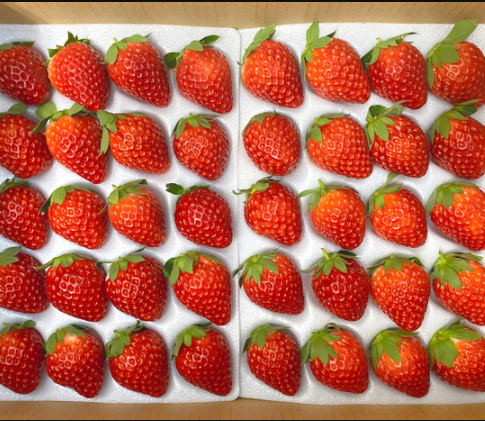 まさかの「温泉イチゴ」 資材メーカーが畑違いの新事業
まさかの「温泉イチゴ」 資材メーカーが畑違いの新事業
Hot Spring Strawberry, a new business in different field
Meiwapax (Kashiwara City, Osaka Prefecture), a packaging material manufacturer, is working on the cultivation of "hot spring strawberries" in Tottori City using hot spring heat and ICT (information and communication technology). It shipped for the first time at the end of last year using a new local variable. Aiming for "next-generation agriculture" that the younger generation longs for.
Shikanocho in the western part of Tottori City. Here, there are two houses (a total of about 1330 square meters, one for raising seedlings) where HYBRID, which is responsible for the agricultural business of Meiwa Pax, grows strawberries.
A plastic pipe is laid at the base of the strawberry, and hot water drawn from the nearby Shikano Onsen is flowing. The air in the room is warmed by the heat, and the heating equipment required in winter for normal greenhouse cultivation is unnecessary. The water temperature is stabilized by mixing hot spring water and groundwater. Meiwapax started farming in different fields in the spring of 2018. It was triggered by recruiting new businesses in-house.
Mr. Susumu Hayakawa (53), an employee who was worried about the decline in Japan's food self-sufficiency rate and the declining farming population, said, "I want to take on the challenge of agriculture." "I want to revitalize Japan from the region," he stuck to the primary industry, which is the main axis of the region's industry.
The company started a new factory in Tottori City in the same year. There was a proposal from the city to grow strawberries using hot spring water, and we decided to work on it as a new business.
The cultivar cultivated is "Toteki", which was registered by the Tottori Prefectural Horticultural Experiment Station in 2018. It has a good balance of sweetness and sourness and is characterized by its tight fruit and less damage during transportation. After one year of demonstration cultivation with the cooperation of local farmers, it has been cultivated in earnest since last year.
Another feature is "smart agriculture" which utilizes ICT. The temperature and humidity of the air in the greenhouse, the temperature and humidity of the cultivated soil, and the amount of sunshine can be measured with sensors and checked 24 hours a day with a smartphone. You can also see the inside of the house through the camera.
The water temperature adjustment in the piping and the opening and closing of windows and curtains are also automatically controlled. It is said that it has been packed with cutting-edge know-how by repeatedly visiting the Netherlands, which is an advanced agricultural country, and several places in Japan. Quality is maintained by improving the efficiency of cultivation, and stable profits can be expected.
The harvest time is from December to May, just like normal greenhouse cultivation. In December of last year, about 260 kg was harvested for the first time and shipped to famous confectionery stores in Hyogo prefecture. The target for the first year is a harvest of 5 tons and sales of about 7.6 million yen. Considering luxury routes, we are considering selling at department stores.
In 2011, we will increase the number of houses, aiming for a yield of 30 tons and sales of 35 million yen. In the summer, he wants to be able to harvest all year round by flowing cold groundwater around and lowering the room temperature.
Mr. Hayakawa, who is in charge of public relations in the new business, said, "The goal is clean, cool, and profitable agriculture that does not rely solely on experience and intuition. I want to help rebuild Japanese agriculture by establishing a model that young people long for." I was enthusiastic.
Source: https://digital.asahi.com/articles/ASP1M73YVP1GPTIL02Z.html?pn=9
 English
English Japan
Japan
